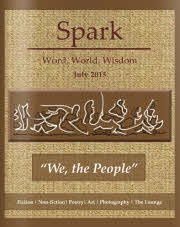by Deepa Padmanaban
When progress and development flow through a city’s arteries, corruption and greed soon follow to clog its ebb. But there is hope in the form of its denizens whose fortitude and values ultimately triumph over the social evils. ‘The Hope Factory’ by Lavanya Sankaran is a poignant tale of modern urban India that juxtaposes modernity and tradition, affluence and poverty.
Eight years ago, the ‘Red Carpet’, with its scintillating prose, humour and irony, giving an insightful look at the cultural clashes of a growing urban city, heralded Sankaran as a gifted storyteller on the shores of the Indian literary scene. Her much-awaited debut novel, set again in the author’s home town, Bangalore, one of the fastest growing cities in India, depicts a similar disquiet.
There are two parallel plots that segue through the book alternately. The first narrative is of Anand Murthy, successful entrepreneur-owner of a car parts-manufacturing company, whose plans of acquiring land takes him through the by-lanes of corruption and goonda-ism. Anand, with a socialite wife and two kids, is a conscientious, caring employer who treats his employees fairly. He is on the verge of acquiring a Japanese car company client, his first international one and a major breakthrough for him, but it also means that he will need to expand the factory, for which he will require more land. He is assisted in this endeavour by a raffish–looking real estate agent, referred by Anand’s friend, but whose comportment seems dubious.
His dogmatic but influential father-in-law, with his own axe to grind, also tries to help him, despite Anand’s protests. The antagonistic relationship with his father-in-law and differing philosophy with his wife lead to a slow breakdown of his marriage, as summed up in these words, “…He had never thought to quarrel with Vidya’s choices or the pressured influences of her parents, quelling his moments of marital rebellion in the interests of domestic peace. Now they were just who they were, destined, it seemed, to continue as such until the end of time, when they would merge into one peculiar and badly-constructed unit…”
It is Anand’s love for his children and his ambition of building a state-of the art factory that keep him going. His search for land leads him to the outskirts of the city to an assortment of farms belonging to different farmers. But the whiff of land and money attracts political goons and just when he is on the brink of sealing the land deal, it is mysteriously jeopardised.
Woven though the story of Anand is that of Kamala, a poor widow who migrates from her village with an infant in tow after being rebuked by her brother with whom she lived. Her determination to seek an independent existence finds her a job as a construction worker for a few years after which she ends up as a domestic worker in Anand’s home. Her life soon revolves around the quotidian events of running the household, the occasional bonhomie and frequent gibes with the other domestic helpers and the tantrums of Anand’s wife Vidya.
But just like Anand, Kamala too is ambitious for her son, Narayan, a clever but easily impressionable boy. Her maternal throes strive to give him a private-English medium education and keep him away from the anti-social elements lurking on the street. Just when things were starting to go well (as Anand promises to sponsor his education), trouble arrives in the form of land developers. The land on which her one-room tenement sits (that’s close to her work-place) is being taken over by the real-estate developers and soon she has to look for accommodation (and a job) elsewhere. How Anand and Kamala overcome their respective adversities form the rest of the story, told with the requisite twists and turns.
Sankaran‘s characterisations are effective – depicted subtly through their personal choices, actions and principles. Interestingly, she makes no attempt to describe the main characters, but the supporting characters, especially the negative ones are etched out deliciously, such as the powerful Sankleshwar who is “a round, squat man remarkable only for his long sideburns, like a seventies movie actor, unmindful of the passage of time and beauty”.
The dialogue is peppy, though frequent use of the colloquial term for the f-word makes it jarring. Poverty, strained relationships, parental woes are all depicted in a manner that’s devoid of angst and exoticism. The commentary on the ills of modern society such as corruption or the murky alliance between real estate and politics are skimmed upon and could have been delved in further. The nuanced and lucid writing, though, makes it an easy and enjoyable read. Sankaran gives us an ambitious debut novel, but it lacks the punch that was delivered in her first collection of stories.
An ex-scientist and then a reluctant homemaker, Deepa found solace in writing at the onset of the mid-life crisis. She hopes that the writing will stay even after mid-life has passed – crisis or no crisis. Her work can be found at www.deepapadmanaban.com and perceptionsofareluctanthomemaker.wordpress.org
Deepa is a member of the Bangalore Writer’s Workshop, an unique, effective and interactive method of bringing a group of writers together and allowing them to study the craft of writing while receiving constructive feedback on their own.







[…] https://sparkthemagazine.com/?p=6103 […]